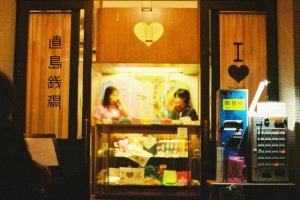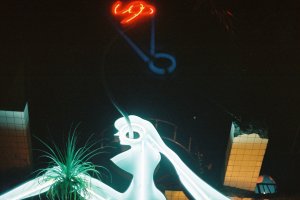If you have plans to travel to Shikoku or have an interest in the arts and architecture, Naoshima is an island you definitely have to visit and going to Naoshima sento is a must.
A 'sento', unlike an 'onsen' which is water from natural hot springs, is boiled water, a communal bath house. Hence it's not always popular with tourists. Most may pass on this opportunity as firstly it's not comfortable to be naked in front of lots of strangers and even more so when it doesn't come with a beautiful scenic backdrop that most onsen tout. But this particular sento on the island of Naoshima, Kawaga-Ken is a must-do on your holiday check-list.
"I Love Yu" ("I♥湯") is the name of this sento. It plays on the Japanese character 'yu’ from ‘お湯’ [o-yu] which means bath. So what sets this sento apart from those around Japan? From the exterior to the interior, the sento is filled with quirky artifacts, lots of old and rather erotic photographs of female divers of the past but I suppose the strangest thing you would encounter would be the elephant placed on top of the wall that separates the female and male baths. If my memory serves me correctly, I read somewhere that the elephant once belonged to the Asahikawa Zoo. In our usual lives, the kind of elephant we'll encounter is likely the imaginary one that fills the room. I wondered then if the 'imaginary elephant' was the room full of naked people. I was perhaps thinking too hard, a psychological distraction perhaps, but it is after-all art and that is subjective. The design is by Shinro Ohtake, an artist who also participated in the Art House Project, which are houses designed by different artists spread across the town.
Branding for this sento is a designer's haven, from the wash buckets, the wash towels, the illustrated bath guide, the taps, the toothpaste/toothbrush set – products all beautifully produced and stamped with "I Love Yu" logo. What can I say – to the items that I faithfully lugged back, I can only say "I love you too".
Ticketing is also rather interesting as it is done on a self-serving ticket machine; pretty much like you're buying your bowl of ramen from the small shops around Japan. It doesn't cost much to enter the bath but it is the little extras that you can buy from the machine that keeps you pressing those buttons. After you're done, pass the tickets to the people at the counter and enter the bath.
An anecdote to share, I was there the day before the official opening of this sento. I walked by and saw people making smalls changes, shifting things around. I took a couple of photos and wondered what this building was. When I came back, a sign was put up. Photos were requested not to be taken as it wasn't ready. It says a lot about the pride they have on the design and how it is to be presented to people. The details that went into this place is art and you can participate in it just by going for a bath. If you've never been to a sento before, there is likely no better sento than this one for your very first experience.
So how do you get to Naoshima sento? The location of this building is very near the pier – a mere 5 minutes walk. From the ferry terminal at night, you can see the bright red neon character 'yu' that rises from the woman in white like a beacon for lost ships.
From Okayama, you can connect to two city ports that have ferries to Naoshima.
Okayama --> Uno Line --> Uno Port
Okayama --> Seto-Hashi Line --> Takamatsu Port
Both lines are from JR but I would recommend taking the Seto-Hashi Line as the route is more scenic and goes over the bridge. It is, however, a longer ride.
































